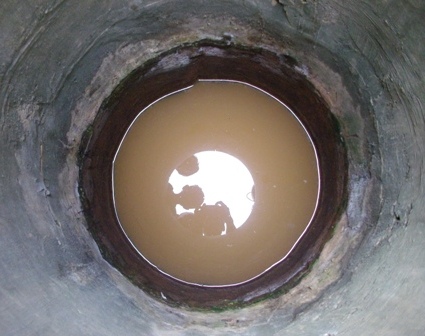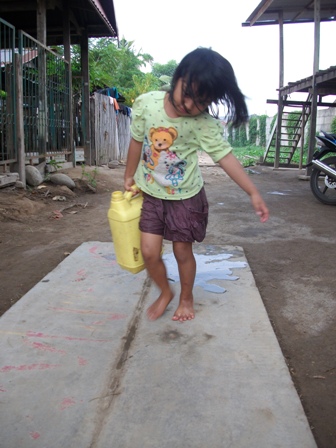![Salah satu bagian Kampung Pisang, Kelurahan Maccini Sombala. [foto: Anwar Jimpe Rachman]](http://ayorek.org/playground/wp-content/uploads/2013/07/ALIM4028.jpg)
Kampung Pisang is a marshy region located in the Kelurahan Maccini Sombala. Had my friend, Cora, not accompanied me, I would have been lost in finding my way there. We must pass through a narrow winding alley to go there. The width of the cemented road is only the size of one bakso (meatball)-selling motorbike. If you are riding a motorcycle and—just your luck!— another bike is going in from the other direction, then one has to pull over to make way for the other.
The village has been inhabited since ten years ago. According to Daeng Sampara, it has been inhabited as early as 2000, when the soil was dredged from the creation of a lake for a rowing training ground from the GMTDC.
![Bocah Kampung Pisang bermain di sekitar sumur mereka. [foto: Anwar Jimpe Rachman]](http://ayorek.org/playground/wp-content/uploads/2013/07/ALIM4025-Copy.jpg)
Children of Kampung Pisang playing near their well. [foto: Anwar Jimpe Rachman]
Sampara practices wood carpentry. This craft of his has allowed him to build a house. He showed some parts of the house that come from different parts, or even different places.
“I’m the only person who used an iron fence here. That’s also what has disqualified me from receiving any support,” said Sampara, laughing. The support that he meant was the government support such as BLT (direct cash support).
Sampara said that the iron fence was acquired from the renovation of a mosque in the neighbouring region The curly-haired man said, he had bought it with his salary as a handyman cut for working in that house of worship.

The water colour inside the well in Kampung Pisang. [foto: Anwar Jimpe Rachman]
![Air sumur di rumah Daeng Sampara. [foto: Anwar Jimpe Rachman]](http://ayorek.org/playground/wp-content/uploads/2013/07/ALIM4017-Copy.jpg)
The well water at the house of Daeng Sampara. [foto: Anwar Jimpe Rachman]
Residents get their water from a house a house 100 meters north of Kampung Pisang. This water is not free. Residents must pay, depending on how often they take the water. On average, for a house like Sampara’s, he pays Rp 50,000 per month.

Water filter used by the residents of Kampung Pisang in washing their clothes [foto: Anwar Jimpe Rachman]
Daeng Sampara took me around the village to see the wells in question. He wanted to prove what he’d just said. He showed the wells in beige. The residents used their clothes and rocks to filter them.
According to this father of five, he used different methods in making his well. When he made this well that located in the rear of the house, he dug the hole wider. And after the well has been lined, he filled it not with the dugout soil, but with sand and gravel. “I do not use ijuk, because it leaves some odour in the water,” said Sampara.

The children of Kampung Pisan help their parents everyday to look for water. [foto: Anwar Jimpe Rachman]
This post is also available in: Indonesian



